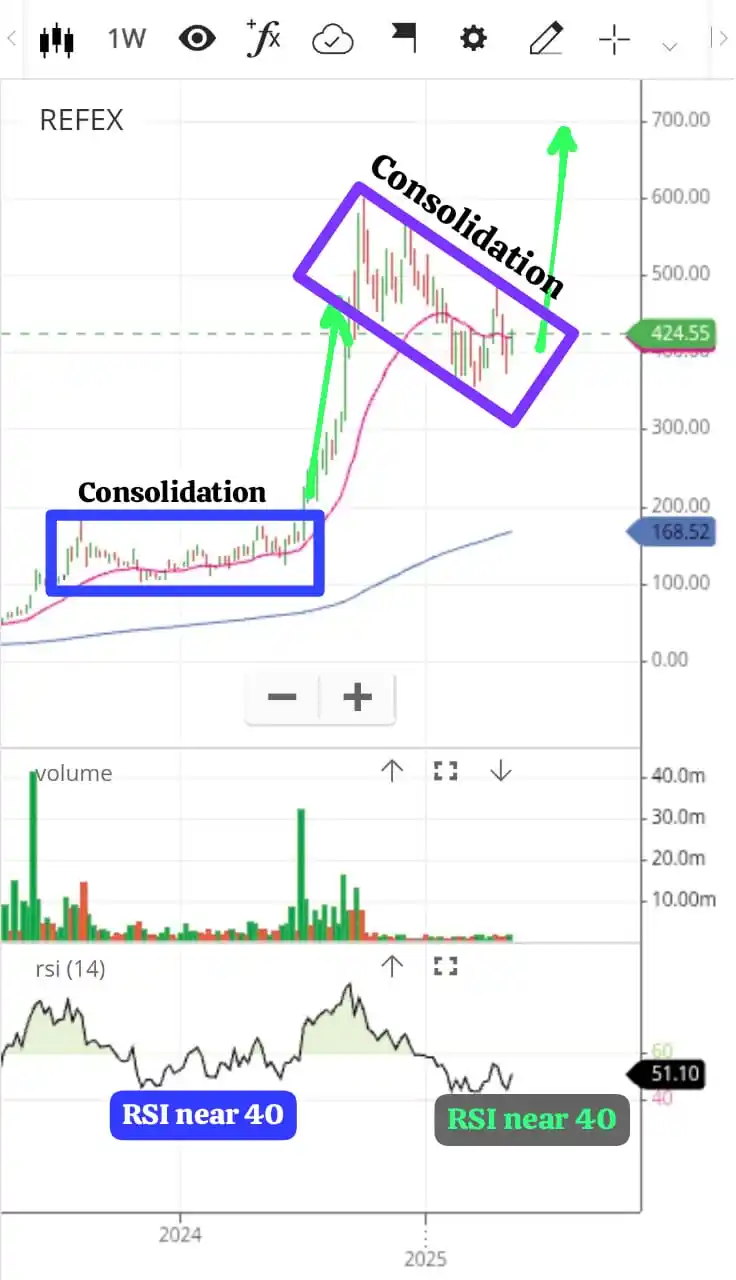
tradêarn ticks
216 subscribers
About tradêarn ticks
STOCK MARKET technical views/ideas *Disclaimer* 📢🎤 •• *The chart/view posted here is for learning and tracking* •• UPDATES ARE PROVIDED ONLY FOR EDUCATIONAL PURPOSE AND ARE SOURCE BASED , DO NOT CONSIDER AS ANY STOCK RECOMMENDATIONS Note :- *Consult certified financial advisor* as per SEBI mandate before any financial decision.
Similar Channels
Swipe to see more
Posts

https://x.com/chartradearn/status/1933396541093654849?t=TRbB30IWKFZw9ym40sFq-Q&s=19

The Reserve Bank of India (RBI) has cut the repo rate by 50 basis points to 5.5%, marking its third consecutive reduction. This move aims to boost economic growth and ease borrowing costs. Here's what you need to know ¹ ²: - *Repo Rate*: Reduced to 5.50% from 6.00% - *Standing Deposit Facility (SDF)*: Adjusted to 5.25% - *Marginal Standing Facility (MSF) & Bank Rate*: Down to 5.75% - *Cash Reserve Ratio (CRR)*: Cut by 100 basis points to 3%, adding to already surplus liquidity The RBI's decision to cut the repo rate is driven by cooled inflation, which dropped to 3.2% in April 2025, the lowest in nearly six years. This trend is attributed to falling food prices, moderate fuel costs, and stable core inflation. The policy stance has shifted from "accommodative" to "neutral" ³. *Impact on Loans and EMIs:* - *Lower Interest Rates*: The rate cut may lead to reduced EMIs for borrowers, making loan repayment more manageable. - *Increased Loan Eligibility*: Lower interest rates can increase loan eligibility, making it easier to qualify for a loan ³. *Economic Projections:* - *GDP Growth Projection*: Unchanged at 6.5% for FY26 - *CPI Inflation Projection*: Down to 3.7% for FY26 from 4% earlier ⁴

SWP 📌Definition: 👉Allows you to withdraw a fixed amount from your mutual fund at regular intervals. 📌How It Works: 👉Invest a large corpus initially. 👉Withdraw a fixed amount periodically (e.g., monthly) to generate regular income. 📌Example: 👉Invest Rs. 10 lakhs in a debt mutual fund, and withdraw Rs. 10,000 monthly. 📌Benefits: 👉Provides steady income. 👉Suitable for retirees or those needing regular cash flow. 👉Flexible withdrawal options.

-By Rayner teo You have a full-time job and you can’t spend hours in front of your screen each day. But at the same time, you don’t want to miss trading opportunities because you can’t monitor the markets. So the question is… How can you profit from the markets without being glued to the screen? Introducing the WOFT method, here’s how it works… 1. What to look for Here’s the deal: There are many different trading strategies out there. Trend continuation, reversal, Support & Resistance, etc. So before you can even “hunt” for trading opportunities, you must first know what to look for. Kind of looking for a partner in a marriage. You must know whether you want a Blonde, Asian, or Brunette? How tall does she need to be? How does she have to look like? You get my point — and it’s the same for trading. 2. Own it Here’s the deal: You must own your trading setup. This means you’ll stick with it come high or low (like how you’re faithful to your partner). Because if you’re inconsistent with your actions, guess what? You get inconsistent results. So, be committed to your trading strategy — and own it. This means taking a minimum of 100 trades of the same setup before you decide to “throw it away”. 3. Find it Now, let’s say you want to trade trend continuation setups on the Daily timeframe. So, what you’ll do is find markets which are trending on the Daily timeframe. Once you’ve done it, write down: The setup The market The timeframe This is important because when the trading week opens, you won’t be like a headless chicken looking for something to trade. You’re prepared like a Spartan and you know what to hunt for. 4. Trade it So you’ve done your “homework”. All that’s left to do is wait for your trading setup. I repeat. You wait for your trading setup. This means no… “Chasing” the markets Entering trades out of boredom Taking trades outside of your trading plan. -Rayner “creator-of-The-WOFT-method” Teo

SIP A disciplined approach to investing a fixed amount in a mutual fund at regular intervals (e.g., monthly). 📌How It Works: 👉Regular investments regardless of market conditions. 👉Purchases more units when the market is low and fewer units when the market is high, averaging the cost over time. 👉Encourages disciplined investing and benefits from compounding. 📌Example: Invest Rs. 5,000 every month: - NAV is Rs. 20: Units bought =5,000/20=250 - NAV is Rs. 16: Units bought =5,000/16=312.50 In this way, units are accumulated by periodically running the NAV of the Fund. 📌Benefits: 👉Easy to invest and monitor. 👉Suitable for long-term goals. 👉Compounding enhances growth.

A reduction in the repo rate can significantly impact your Equated Monthly Installments (EMIs). Here's what you need to know: Impact on EMIs - *Lower Interest Rates*: When the Reserve Bank of India (RBI) cuts the repo rate, banks can borrow money at a lower rate. This reduction is often passed on to consumers, leading to lower interest rates on loans. - *Reduced EMIs*: With lower interest rates, your EMIs may decrease, making it more manageable to repay your loan. For instance, a 25-basis point rate cut on a ₹50 lakh home loan at 8.50% for 20 years can lower the EMI from ₹43,059 to ₹42,452, saving ₹607 monthly ¹. - *Floating Rate Loans*: If you have a floating rate loan, you're more likely to benefit from a repo rate cut. Your loan's interest rate is tied to market rates, so a reduction in the repo rate will directly impact your EMI. Benefits for Borrowers - *Increased Loan Eligibility*: Lower interest rates can increase your loan eligibility, making it easier to qualify for a loan. - *Shorter Loan Tenure*: You can choose to retain your current EMI amount and reduce the loan tenure, saving on interest costs over the long term ². Key Considerations - *Individual Bank Policies*: Banks may vary in the extent of the reduction they pass on to borrowers. Some might pass on the full reduction, while others might only partially reduce the interest rate. - *Fixed vs. Floating Rates*: If you have a fixed-rate loan, a repo rate cut won't affect your EMI. However, if you have a floating-rate loan, you can expect a reduction in your EMI ³. Keep in mind that the actual impact of a repo rate cut on your EMI will depend on your loan terms, interest rate, and lender policies. It's essential to review your loan agreement and consult with your lender to understand how a repo rate cut will affect your specific situation.

RSI near support but in consolidation. Soon it may fly for upmove Refex


The repo rate, set by the Reserve Bank of India (RBI), significantly impacts the equity market. Here's how: Impact on Equity Market - *Lower Interest Rates*: When the RBI cuts the repo rate, borrowing becomes cheaper. This encourages companies to invest in new projects, expand operations, and fund innovation, ultimately boosting economic growth and stock prices. - *Increased Consumer Spending*: Lower interest rates lead to reduced loan costs, increasing consumer spending and stimulating growth across sectors. - *Market Sentiment*: A repo rate cut is generally seen as positive for stocks, as it indicates a shift towards monetary easing and economic stimulus ¹ ². Recent Developments - *Repo Rate Cut*: On June 6, 2025, the RBI cut the repo rate by 50 basis points to 5.5%, marking its third consecutive rate cut this year. This move aims to boost economic growth and ease borrowing costs. - *Market Reaction*: Following the rate cut, Indian equity markets rebounded, with Nifty Bank hitting a record high ³. Key Considerations - *Economic Growth*: Lower interest rates can boost economic growth by increasing borrowing and spending. - *Inflation Control*: However, the RBI must balance growth with inflation control, as excessive money supply can lead to inflationary pressures. - *Global Economic Conditions*: Global events, such as changes in US Federal Reserve rates or signs of a global recession, can influence the RBI's stance on repo rates ¹.

A change in the repo rate significantly impacts fixed deposit (FD) interest rates. Here's what you need to know: Impact on Existing FDs - *No Change*: If you already have an FD, the interest rate remains unchanged until maturity. You won't be affected by the repo rate cut. - *Renewal*: When your FD matures, renewal might offer a lower rate if banks cut their rates in response to the repo rate change ¹. Impact on New FDs - *Lower Interest Rates*: When the repo rate is lowered, banks may reduce FD rates. This means new FD investments will likely earn lower interest rates. - *Higher Interest Rates*: Conversely, when the repo rate increases, banks often raise FD interest rates to compensate for higher borrowing costs, resulting in better returns for FD investors. Strategies for FD Investors - *Lock in Higher Rates*: If repo rates have been cut, FD rates may soon decrease. It's better to lock in current higher rates before they drop further. - *FD Laddering*: Consider using FD laddering strategies to optimize returns in a changing rate environment. - *Special Tenure FDs*: Look into special tenure FDs, like 444-day or 555-day deposits, which may still offer attractive rates ¹. Key Takeaway The repo rate change directly affects FD interest rates. When the repo rate is cut, FD rates tend to decrease, and when it's hiked, FD rates tend to increase. Keep an eye on repo rate changes to make informed decisions about your FD investments ².

STP 👉Transfers investments from one mutual fund scheme to another within the same fund house. 📌How It Works: 👉Invest a lump sum in a liquid fund. 👉Transfer a fixed amount regularly to an equity fund to mitigate risk. 📌Example: 👉Invest Rs. 5 lakhs in a liquid fund, transfer Rs. 50,000 monthly to an equity fund. 📌Benefits: 👉Gradual investment in equity reduces risk. 👉Earn potential returns on both source and target funds.












